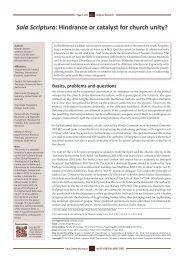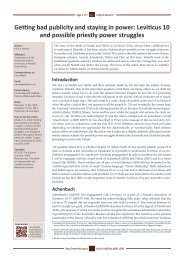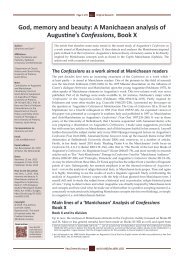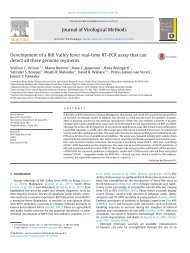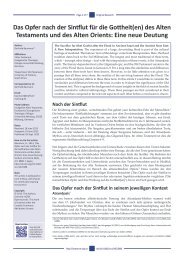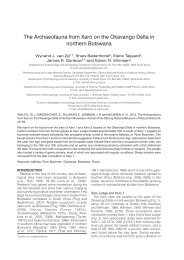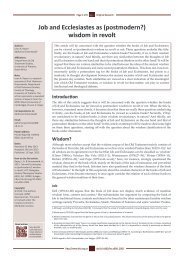View/Open - University of Pretoria
View/Open - University of Pretoria
View/Open - University of Pretoria
You also want an ePaper? Increase the reach of your titles
YUMPU automatically turns print PDFs into web optimized ePapers that Google loves.
Subtest<br />
Total Test<br />
Subtest(s)<br />
1<br />
Subtest(s)<br />
2<br />
Subtest(s)<br />
3<br />
Subtest(s)<br />
4<br />
Subtest(s)<br />
5<br />
Subtest(s)<br />
6<br />
Subtest(s)<br />
7<br />
Number <strong>of</strong> items : 88 5 10 5 10 33 15 10<br />
Average test score : 61.33 2.66 6.56 4.19 7.60 23.75 8.96 7.62<br />
Standard deviation : 14.19 1.92 2.89 0.93 1.83 4.89 4.52 2.85<br />
SEM : 3.82 0.75 1.22 0.75 1.24 2.30 1.51 1.00<br />
Average,<br />
P-value : 69.7 53.16 65.64 83.76 75.98 71.98 59.72 76.15<br />
Coefficient Alpha : 0.93 0.85 0.82 0.35 0.54 0.78 0.89 0.88<br />
GLB : 1.00 0.94 0.89 0.41 0.74 0.94 0.96 0.92<br />
Asymptotic GLB : Na Na Na Na Na Na Na Na<br />
Davies et al. (1999) explain that a correlation coefficient is a value showing the degree<br />
to which two variables are related, that a coefficient <strong>of</strong> zero indicates that there is no<br />
relationship between the two variables, a coefficient <strong>of</strong> -1 indicates a perfect negative<br />
correlation, and a coefficient <strong>of</strong> +1indicates a perfect positive correlation (1999:36).<br />
In terms <strong>of</strong> the correlation between each pair <strong>of</strong> subtests, these should fall between<br />
0,3–0,5 (Alderson, Clapham & Wall, 1995:184). Alderson et al. explain that the reason<br />
for having different test components is that they all measure something different and<br />
therefore contribute to the overall picture <strong>of</strong> language ability attempted by the test. These<br />
correlations should be fairly low, in the “order <strong>of</strong> +.3 - +.5” (Alderson et al. 1995:184). If,<br />
however, these components correlate very highly (around +.9) one may wonder whether<br />
the two subtests are testing different traits or skills, or whether they are testing the same<br />
thing (1995:184). Of the 21 correlations in the table above, 9 fall below 0.3. Should this be<br />
adjusted, in line with the experience with TALL, these levels to 0.2 and 0.5, then 15 <strong>of</strong> the<br />
21 are between the acceptable parameters. With regards the correlation between each<br />
subtest and the whole test, this should be “around +.7 or more since the overall score is<br />
taken to be a more general measure <strong>of</strong> language ability than each individual component<br />
score” (Alderson et al. 1995:184). Overall the average <strong>of</strong> the correlation between each<br />
subtest and the whole test, while not ideal, is an acceptable 0.64. The subtests that<br />
correlate best with the whole test are the Interpreting Graphs, Understanding Texts and<br />
the Grammar and Text Relations subtest. In the case <strong>of</strong> the TALPS final draft version (UP<br />
& UNW combined) (See Table 5 below), the average <strong>of</strong> the correlations between each<br />
subtest and the whole test is 0.66, indicating that the subtests correlate well, and more<br />
acceptably, with the test.<br />
187<br />
Journal for Language Teaching | Tydskrif vir Taalonderrig



